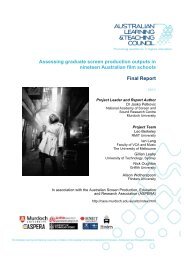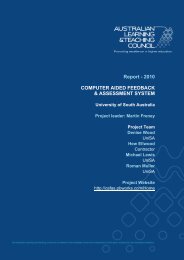Download Document - Office for Learning and Teaching
Download Document - Office for Learning and Teaching
Download Document - Office for Learning and Teaching
Create successful ePaper yourself
Turn your PDF publications into a flip-book with our unique Google optimized e-Paper software.
0 Executive SummaryAustralian tertiary education has attracted a large number of international students,particularly from Asia. Cultural factors have affected the quality of learning ofinternational students <strong>and</strong> the teaching approaches adopted by Australian lecturers.There<strong>for</strong>e, cross-cultural teaching <strong>and</strong> learning situations have become an importantissue in Australian universities. This project intends to identify the influence of thetrend towards increasing numbers of cross-cultural students on teaching <strong>and</strong>learning approaches in an Australian educational environment. It aims to improvethe underst<strong>and</strong>ing of Asian students' cultural backgrounds, their previous learningapproaches <strong>and</strong> their perspectives on Australian culture <strong>and</strong> modes of education,with the objective of helping international students to overcome the difficulties ofcross-cultural study. In the process, we anticipate bringing new ideas to lecturers<strong>and</strong> education managers to improve the quality of cross-cultural teaching <strong>and</strong>learning. We also expect to develop strategies through recognising the factors whichinfluence teaching <strong>and</strong> learning in the cross-cultural environment, <strong>and</strong> to propose aset of guidelines <strong>and</strong> suggestions that can enhance the quality of teaching <strong>and</strong>learning in Australian universities.In 2008, we conducted a student questionnaire survey at the University ofTechnology, Sydney, Curtin University of Technology, The University of Sydney,Edith Cowan University <strong>and</strong> Southern Cross University. As Business <strong>and</strong>In<strong>for</strong>mation Technology attract the majority of Asian international students, weselected these two schools/faculties in the five universities within which to conductthe survey. We received a total of 1026 completed student questionnaires fromundergraduate <strong>and</strong> postgraduate students, of whom 37.7% were Australian localstudents <strong>and</strong> 62.3% were international students from 56 other countries. Weconducted data analysis, including frequency analysis <strong>and</strong> correlation analysis, totest designed hypotheses. Following the survey, we conducted 50 interviews in thefive universities to obtain more detailed in<strong>for</strong>mation about teaching <strong>and</strong> learningissues in a cross-cultural education environment <strong>and</strong> to further underst<strong>and</strong> theneeds of students of Asian background in depth. The interview participants included10 lecturing staff, 25 students of Asian background, seven Australian local students<strong>and</strong> eight graduates of Asian background. The interview data was analysed byword-based text mining <strong>and</strong> other qualitative approaches.Based on the survey <strong>and</strong> interview data collected, our study found that internationalstudents experience significant cross-cultural <strong>and</strong> language difficulties in theirlearning process.Their cross-cultural learning difficulties manifest in the following ways:- The teaching methods used in Australian universities, specifically in classroominteraction <strong>and</strong> face-to-face teaching, are significantly different from those usedin Asian countries. Open questions show that some 53% of internationalundergraduate students <strong>and</strong> 57.87% of international postgraduate studentsindicated that the main difference between the universities in their home country<strong>and</strong> Australia is in the teaching methods. These students have difficulty in readilyaccepting Australian teaching methods, particularly in their first year at Australianuniversities. Many of them prefer more face-to-face teaching <strong>and</strong> fewer studentquestions or class discussions during lectures. Some Asian students consider itto be a mark of appreciation <strong>and</strong> respect <strong>for</strong> their teachers <strong>for</strong> students to listenattentively <strong>and</strong> quietly in class. They consider that all discussion should takeplace after classes as any discussion will impinge on the teacher’s lecture time,resulting in reduced knowledge transmission to students, with the consequencethat students will learn less.4
















